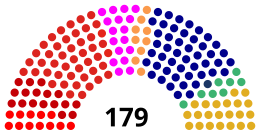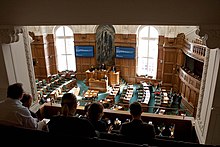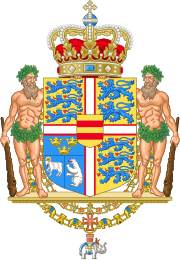Folketing
The Danish Parliament Folketinget | |
|---|---|
 | |
| Type | |
| Type | |
| Leadership | |
Speaker | |
| Structure | |
| Seats | 179 |
 | |
Political groups | 12 Government (65)
Supported by (27)
Opposition (87)
|
| Elections | |
| Open list proportional representation with a 2% election threshold | |
Last election | 15 September 2011 |
Next election | 14 September 2015 or earlier |
| Meeting place | |
 | |
| Christiansborg Palace, Copenhagen | |
| Website | |
| www | |
The Folketing (Danish: Folketinget, Danish pronunciation: [ˈfʌlɡ̊ətˢeŋˀ]; lit. the people's thing), is the unicameral national parliament of the Kingdom of Denmark. Established in 1849, until 1953 the Folketing was the lower house of a bicameral parliament, the Rigsdag; the upper house was the Landsting. It meets in Christiansborg Palace, on the islet of Slotsholmen in central Copenhagen.
As the legislative branch of Denmark, the Folketing passes all laws, approves the cabinet, and supervises the work of the government. As set out in the Danish Constitution, the Folketing shares power with the reigning monarch. In practice, however, the monarch's role is limited to signing laws passed by the legislature. This must be done within 30 days of adoption.
The Folketing consists of 179 representatives; 175 from Denmark, 2 from Greenland and a further 2 from the Faroe Islands. Parliamentary elections are held at least every four years, but it is within the powers of the Prime Minister to ask the monarch to call for an election before the term has elapsed. On a vote of no confidence, the Parliament may force a single Minister or the entire government to resign.[1]
The Danish political system has traditionally generated coalitions. Most Danish post-war governments have been minority coalitions ruling with the support of non-government parties.[2]
Members are elected by proportional representation: 135 by the D'Hondt method and 40 by the Sainte-Laguë method. The most recent general election took place on 15 September 2011.
History

From 1849 to 1953 the Folketing was one of the two houses in the bicameral parliament known as the Rigsdag; the other house was known as the Landsting. Since both houses, in principle, had equal power, the terms "upper house" and "lower house" were not used. The difference between the houses was voter representation.
The Folketing was elected by common vote and consisted mainly of independent farmers, traders, and merchants as well as the educated classes (i.e., the liberal forces of society). From 1866 to 1915 the right of vote for the Landsting was restricted to the wealthiest, and some of its members were appointed by the king, thus it predominantly represented the landed gentry and other conservatives. From 1915 the Landsting was also elected by common vote, although indirectly and with a higher age limit than for the Folketing. During the next decades, law-making mainly took place in the Folketing and the Landsting came to be regarded as a superfluous rubber stamp.
In 1953 the people by popular vote adopted a revised constitution. Among the changes was the elimination of the Landsting and the introduction of a unicameral parliament, known only as the Folketing. Christiansborg Palace (also known by its nickname, "Borgen"--Danish for "the castle") has been the domicile of parliament since 1849. The palace is located in the heart of Copenhagen.
Since parties need only 2% of the vote to get a seat, several parties win seats, making it all but impossible for one party to win the 90 seats required for a majority. No party has won an outright majority in the Folketing since 1901. All Danish governments since then have been coalitions or one-party minority governments. For this reason, a long-standing provision in the constitution allows a government to begin rule without getting a vote of confidence, as long as it does not lose a vote of no confidence during the parliamentary term. One consequence is that unlike in most other parliamentary systems, a cabinet must usually piece together a majority for each piece of legislation.
Constitutional requirements
- Composition of members
- The Folketing consists of 179 members all elected for a four-year term or until the Prime Minister (via the Queen-in-council) calls for elections, whichever comes first. Greenland and the Faroe Islands each elect 2 members separately.
- The constitution does not mention political parties at all, although the electoral act does, and MPs are almost always elected for a party. The only independent who has been elected in modern times is the comedian Jacob Haugaard, but independents, usually unknown ones, are seen at every election. Requirements for standing as an independent candidate are much more lenient than for a new party (signatures from 150 eligible voters), but independents are only allowed to contest in a single district, making it very difficult to gain the needed number of votes for a seat.
- Voting system
- The Constitution requires for "equal representation of the various opinions of the electorate", and for regional representation to be secured. The electoral act stipulates the details for this: 135 seats are elected by proportional representation in 10 districts, and 40 supplementary seats are allotted to make out for the difference between district and nation-wide vote. The 135 seats are distributed to the parties by the D'Hondt method of the party-list system of proportional representation and the 40 supplementary seats by the Sainte-Laguë method. Each party may choose among a number of methods for how the seats won by that party are to be distributed among the candidates.[3]
- The result is proportional representation; however, in rare cases, the biggest parties may gain one or two seats extra from smaller parties.
- The voter may vote for a party list, one of the candidates on a party list, or an independent candidate.
- Parties (usually district party assemblies) decide on the nomination of candidates before the election. When co-nomination is assigned, candidates are elected according to personal votes. When priority order is assigned, only an extreme number of personal votes can change the rank.
- Parties must either pass the threshold, 2% of the national vote, or gain a district seat to gain any supplemental seats. Though possible, it is very rare for a party to gain a district seat without getting 2% of the national vote. There is also an esoteric third rule that allows a party to be represented, if it has enough votes in two of the three areas that the country is divided into. No party has ever fulfilled this rule without getting 2% of the national vote.
- To stand for election, parties that are not currently represented in Parliament must collect certificates of support from approximately 20,000 voters (the number of valid votes cast in Denmark proper at the latest election, divided by 175 — the equivalent of one seat; after the 2007 election the required number is 19,769) and have these individually stamped by the registration office in these voters' municipalities of residence.
- Voter requirements
- Denmark has universal suffrage for all citizens over 18 years who live in the realm and who have not been declared incapable of managing their own affairs. The constitution makes it possible to restrict suffrage for convicted criminals and people receiving social benefits, but this option has not been used for several decades.
- All voters who have not been convicted of criminal acts that makes them unworthy for a seat in the parliament, are eligible. The Folketing decides if a member is eligible or not (after his election).


- Parliamentary privileges
- Members enjoy immunity, meaning that no criminal charges may be brought against an MP, unless he is caught red-handed, provided that the Folketing does not lift the immunity. The purpose of this is to prevent political persecution. In practice, the Folketing has always lifted the immunity when a member has been accused of a crime, usually with the consent of the accused member himself.
- Debates can be conducted behind closed doors, although this has not happened since 9 April 1940, day of the German invasion in WW II.
- Ministers
- Ministers may hold a seat in parliament, but they do not need to. Supreme Court judges — according to convention — may not hold a seat whilst also acting as judges.
- Ministers may — even if they are not MPs — demand talking time whenever they want.
- Legislating
- Bills may be brought before parliament by members (private member's bills) and ministers. Bills are predominantly brought before parliament by ministers, because they have the Law Office of the Ministry of Justice at their disposal. Instead of putting forward a private bill, the opposition usually put forward a proposal for parliamentary decision, i.e., a short resolution that addresses the subject and directs the relevant minister to propose a bill concerning it.
Forming a parliament
The 179 members of the folketing are directly elected to four-year terms, subject to calls for early elections. All Danish citizens 18 years or older may vote in legislative elections, which are conducted by secret ballot. Folketing seats are allocated among the various parties using the D'Hondt method of party list proportional representation. A party or electoral alliance must pass the election threshold of 2% of the overall vote to be allocated a seat. Parties select their candidates using a closed list. Thus, voters select the party of their choice, not any specific candidate.
Coalition governments
The former Prime Minister, Lars Løkke Rasmussen, led a centre-right minority government consisting of the Liberal Party (Venstre) and the Conservative People's Party. This coalition government worked with regular parliamentary support from the national conservative Danish People's Party and often gained the necessary 90th seat for majority in the Folketing through negotiations with either the sole MP from the Christian Democrats, Ørum-Jørgensen[4] or another MP outside parties, Christmas Møller, both elected in 2007 as conservative MPs and having defected since then.
Since the 2007 elections, the Liberal Alliance (previously Ny Alliance) have gained momentum in opinion polls, and since early 2010, the governing coalition have not been able to gather a majority in the polls without the support of the Alliance. The continuing rise in the polls is to an extent the result of the internal crisis in the Conservative People's Party over the leadership Lene Espersen[5] and the continuing debate over a lack of "true" liberal/conservative ideology in government policy.[6]
On 13 January 2011, the continuing turmoil within the Conservative group in the Folketing caused Lene Espersen to resign as political leader of the party and focus on her role as Minister of Foreign Affairs.[7] A leadership election between Brian Mikkelsen, the Minister of Economic and Business Affairs and Lars Barfoed, the Justice Minister, was widely expected,[8] but on 14 January the Conservative group in the Folketing unanimously elected Barfoed as their new political leader.[9]
The Social Democrats under the leadership of Helle Thorning-Schmidt have enjoyed continuing majorities in opinion polls since late 2009 and hopes to form a centre-left government coalition consisting of the Socialist People's Party and the Social Liberal Party with parliamentary support from the small Red-Green Alliance.[10][11]
Both Margrethe Vestager (Social Liberal Party) and Villy Søvndal (Socialist People's Party) pledged their support to Thorning-Schmidt before the election.[12] But there has been considerable debate about the future politics of this coalition, mainly because the Social Liberal Party demands a more liberal economic agenda. Also on immigration issues there are political differences between the three coalition parties. This has led some observers to believe that the Social Liberal Party will not join a government coalition but instead opt to be a part of the parliamentary support of a new, centre-left government.[13] In the event the Social Liberals did join the new three-party coalition government formed on 3 October.
Latest election results

 |
|---|
Template:Danish parliamentary election, 2011 The Social Democrats, Social Liberal Party and the Socialist People's Party form a three-party government. The new parliament convened on 4 October, the first Tuesday of the month.
List of Speakers

| From | To | Speaker of the Folketing | Lifespan |
|---|---|---|---|
| 30 January 1850 | 3 August 1852 | Carl Christoffer Georg Andræ, NL | 1812–1893 |
| 4 October 1852 | 12 June 1853 | Johan Nicolai Madvig, NL | 1804–1886 |
| 13 June 1853 | 2 December 1859 | Carl Edvard Rotwitt, BV | 1812–1860 |
| 3 December 1859 | 2 December 1870 | Laurids Nørgaard Bregendahl, NL | 1811–1872 |
| 3 December 1870 | 30 September 1883 | Christopher Krabbe, V | 1833–1913 |
| 1 October 1883 | 2 October 1887[note 1] | Christen Berg, V | 1829–1891 |
| 3 October 1887 | 16 December 1894 | Sofus Høgsbro, V | 1822–1902 |
| 17 December 1894 | 16 April 1895 | Rasmus Claussen, V | 1835–1905 |
| 17 April 1895 | 4 October 1901 | Sofus Høgsbro, V | 1822–1902 |
| 5 October 1901 | 30 January 1905 | Herman Trier, V | 1845–1925 |
| 31 January 1905 | 14 March 1912 | Anders Thomsen, V | 1842–1920 |
| 15 March 1912 | 13 June 1913 | Jens Christian Christensen, V | 1856–1930 |
| 14 June 1913 | 29 March 1922 | Niels Pedersen-Nyskov, V | 1850–1922 |
| 7 April 1922 | 10 April 1924 | Jørgen Jensen-Klejs, V | 1863–1947 |
| 30 April 1924 | 24 November 1932 | Hans Peter Hansen, S | 1872–1953 |
| 30 November 1932 | 1 May 1933 | Gerhard Nielsen, S | 1871–1933 |
| 9 May 1933 | 30 October 1945 | Hans Rasmussen, S | 1873–1949 |
| 22 November 1945 | 22 February 1950 | Julius Bomholt, S | 1896–1969 |
| 23 February 1950 | 22 September 1964 | Gustav Pedersen, S | 1893–1975 |
| 6 October 1964 | 22 January 1968 | Julius Bomholt, S | 1896–1969 |
| 6 February 1968 | 30 September 1978 | Karl Skytte, B | 1908–1986 |
| 3 October 1978 | 8 December 1981 | Knud Børge Andersen, S | 1914–1984 |
| 22 December 1981 | 10 January 1989 | Svend Jakobsen, S | b. 1935 |
| 10 January 1989 | 3 October 1989 | Erik Ninn-Hansen, C | b. 1922 |
| 3 October 1989 | 15 January 1993 | H. P. Clausen, C | 1928–1998 |
| 27 January 1993 | 5 October 1994 | Henning Rasmussen, S | 1926–1997 |
| 5 October 1994 | 11 March 1998 | Erling Olsen, S | 1927–2011 |
| 26 March 1998 | 11 March 2003†[note 2] | Ivar Hansen, V | 1938–2003 |
| 18 March 2003 | 13 November 2007 | Christian Mejdahl, V | b. 1939 |
| 28 November 2007 | 4 October 2011 | Thor Pedersen, V | b. 1945 |
| 4 October 2011 | Incumbent | Mogens Lykketoft, S | b. 1946 |
| References:[14][15][16] | |||
See also
- Cabinet of Denmark
- Elections in Denmark
- Elections in the Faroe Islands
- Elections in Greenland
- List of Prime Ministers of Denmark
- Løgting – Faroe Islands
- Inatsisartut – Greenland
- Politics of Denmark
- Politics of the Faroe Islands
- Politics of Greenland
Notes
- ^ Sofus Høgsbro, V was acting speaker from 25 January to 24 July 1886
- ^ Ivar Hansen died in office. His successor was not appointed immediately, and in the meantime Svend Auken, S was acting speaker.
References
- ^ "A Minister shall not remain in office after the Parliament has passed a vote of no confidence in him." The Constitution of Denmark – Section 15.
- ^ "Radikale ved historisk skillevej". Berlingske Tidende. 17 June 2007. Retrieved 17 August 2007.
- ^ Det danske valgsystem. Valg til Folketinget Template:Da icon. Ministry of the Interior and Social Affairs
- ^ "Kristendemokraterne vil med i finansloven" (in Danish). Politiken.dk. 26 July 2011. Retrieved 16 September 2011.
- ^ "Lene Espersens krise smitter af på Løkke – Politiko | www.b.dk". Berlingske.dk. Retrieved 16 September 2011.
- ^ Af Uffe Tang og Christian Brøndum. "Liberal Alliance redder regeringen – Politiko | www.b.dk". Berlingske.dk. Retrieved 16 September 2011.
- ^ Af Lene Frøslev. ""Det er den rigtige beslutning" – Politiko | www.b.dk". Berlingske.dk. Retrieved 16 September 2011.
- ^ Af Morten Henriksen og Chris Kjær Jessen. "Både Barfoed og Brian vil afløse Lene – Politiko | www.b.dk". Berlingske.dk. Retrieved 16 September 2011.
- ^ Af Louise Lyck Dreehsen. "Barfoed taler til pressen – Politiko | www.b.dk". Berlingske.dk. Retrieved 16 September 2011.
- ^ "Rød dominans – Politik". BT.dk. 13 June 2010. Retrieved 16 September 2011.
- ^ "Greens: Markant rødt flertal – dr.dk/Nyheder/Politik". Dr.dk. Retrieved 16 September 2011.
- ^ "Vestager peger på Helle Thorning". Borsen.dk. 20 October 2008. Retrieved 16 September 2011.
- ^ "Radikale med i regering – hvis ... – dr.dk/Nyheder/Politik". Dr.dk. 19 August 2010. Retrieved 16 September 2011.
- ^ Bomholt, Jul.; Fabricius, Knud; Hjelholt, Holger; Mackeprang, M.; Møller, Andr. (1953). "Rigsdagens formænd 1848–1949". Den danske rigsdag 1849–1949 bind VI (in Danish). Copenhagen: J. H. Schultz Forlag. p. 491.
- ^ Skou, Kaare R. (2005). Dansk politik A-Å (in Danish). Aschehoug. p. 770. ISBN 87-11-11652-8.
- ^ "Folketingets formænd siden 1933" (in Danish). Folketinget. Retrieved 18 May 2007.

